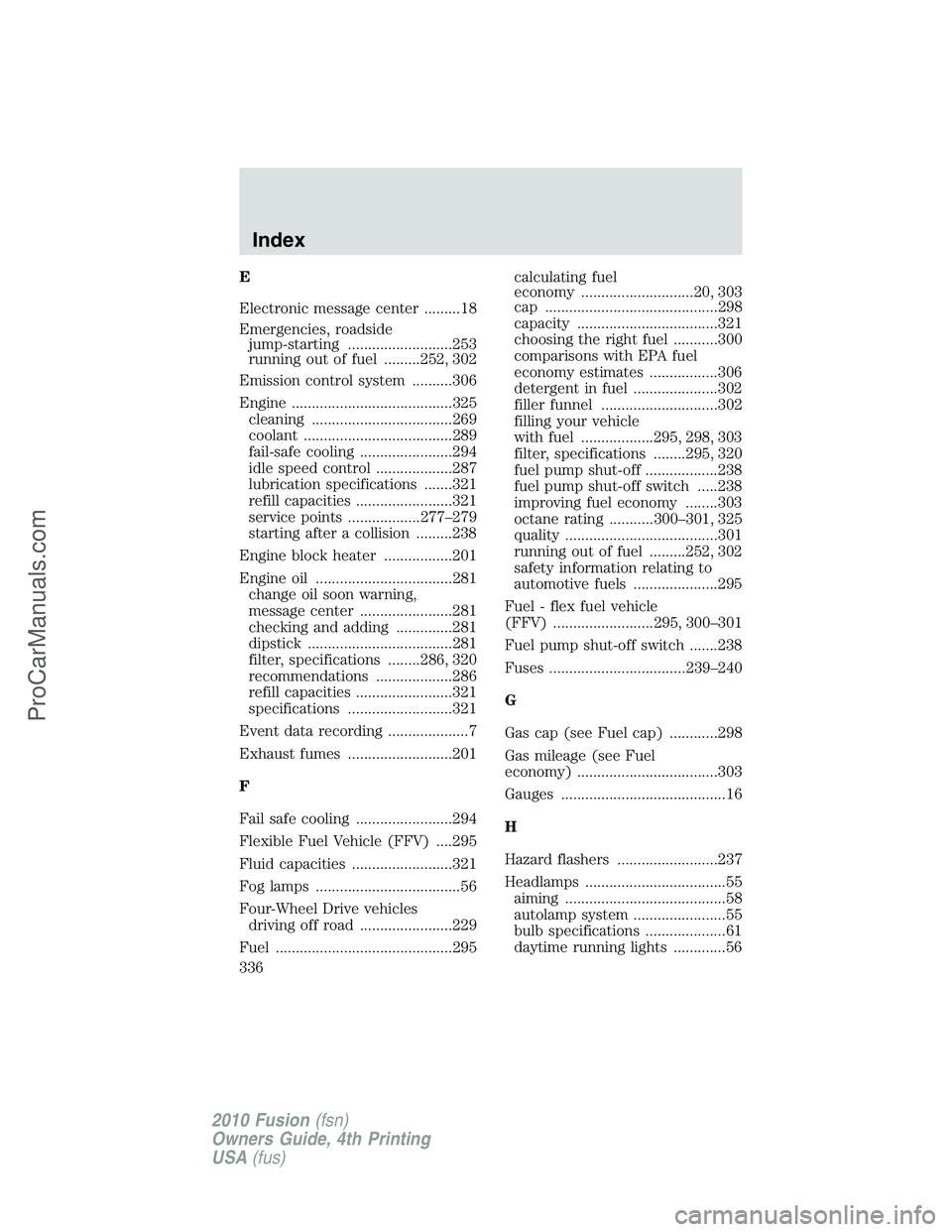Page 233 of 340

When climbing a steep slope or hill, start in a lower gear rather than
downshifting to a lower gear from a higher gear once the ascent has
started. This reduces strain on the engine and the possibility of stalling.
If you do stall out, do not try to turnaround because you might roll over.
It is better to back down to a safe location.
Apply just enough power to the wheels to climb the hill. Too much
power will cause the tires to slip, spin or lose traction, resulting in loss of
vehicle control.
Descend a hill in the same gear you
would use to climb up the hill to
avoid excessive brake application
and brake overheating. Do not
descend in neutral; instead,
disengage overdrive or manually
shift to a lower gear. When
descending a steep hill, avoid
sudden hard braking as you could
lose control. The front wheels have
to be turning in order to steer the
vehicle.
Your vehicle has anti-lock brakes, therefore apply the brakes steadily. Do
not “pump” the brakes.
Driving on snow and ice
Note:Excessive tire slippage can cause transmission damage.
AWD vehicles have advantages over 2WD vehicles in snow and ice but
can skid like any other vehicle.
Should you start to slide while driving on snowy or icy roads, turn the
steering wheel in the direction of the slide until you regain control.
Avoid sudden applications of power and quick changes of direction on
snow and ice. Apply the accelerator slowly and steadily when starting
from a full stop.
Avoid sudden braking as well. Although an AWD vehicle may accelerate
better than a two-wheel drive vehicle in snow and ice, it won’t stop any
faster, because as in other vehicles, braking occurs at all four wheels. Do
not become overconfident as to road conditions.
Make sure you allow sufficient distance between you and other vehicles
for stopping. Drive slower than usual and consider using one of the lower
gears. In emergency stopping situations, apply the brake steadily. Since
Driving
233
2010 Fusion(fsn)
Owners Guide, 4th Printing
USA(fus)
ProCarManuals.com
Page 234 of 340

your vehicle is equipped with a four wheel anti-lock brake system (ABS),
do not “pump” the brakes. Refer to theBrakessection of this chapter
for additional information on the operation of the anti-lock brake system.
WARNING:If you are driving in slippery conditions that require
tire chains or cables, then it is critical that you drive cautiously.
Keep speeds down, allow for longer stopping distances and avoid
aggressive steering to reduce the chances of a loss of vehicle control
which can lead to serious injury or death. If the rear end of the vehicle
slides while cornering, steer in the direction of the slide until you
regain control of the vehicle.
Maintenance and modifications
The suspension and steering systems on your vehicle have been designed
and tested to provide predictable performance whether loaded or empty
and durable load carrying capability. For this reason, Ford Motor
Company strongly recommends that you do not make modifications such
as adding or removing parts (such as lift kits or stabilizer bars) or by
using replacement parts not equivalent to the original factory equipment.
Any modifications to a vehicle that raise the center of gravity can make
it more likely the vehicle will rollover as a result of a loss of control.
Ford Motor Company recommends that caution be used with any vehicle
equipped with a high load or device (such as ladder or luggage racks).
Failure to maintain your vehicle properly may void the warranty, increase
your repair cost, reduce vehicle performance and operational capabilities
and adversely affect driver and passenger safety. Frequent inspection of
vehicle chassis components is recommended if the vehicle is subjected to
heavy off-highway usage.
DRIVING THROUGH WATER
If driving through deep or standing
water is unavoidable, proceed very
slowly especially when the depth is
not known. Never drive through
water that is higher than the bottom
of the wheel rims (for cars) or the
bottom of the hubs (for trucks).
Driving
234
2010 Fusion(fsn)
Owners Guide, 4th Printing
USA(fus)
ProCarManuals.com
Page 336 of 340

E
Electronic message center .........18
Emergencies, roadside
jump-starting ..........................253
running out of fuel .........252, 302
Emission control system ..........306
Engine ........................................325
cleaning ...................................269
coolant .....................................289
fail-safe cooling .......................294
idle speed control ...................287
lubrication specifications .......321
refill capacities ........................321
service points ..................277–279
starting after a collision .........238
Engine block heater .................201
Engine oil ..................................281
change oil soon warning,
message center .......................281
checking and adding ..............281
dipstick ....................................281
filter, specifications ........286, 320
recommendations ...................286
refill capacities ........................321
specifications ..........................321
Event data recording ....................7
Exhaust fumes ..........................201
F
Fail safe cooling ........................294
Flexible Fuel Vehicle (FFV) ....295
Fluid capacities .........................321
Fog lamps ....................................56
Four-Wheel Drive vehicles
driving off road .......................229
Fuel ............................................295calculating fuel
economy ............................20, 303
cap ...........................................298
capacity ...................................321
choosing the right fuel ...........300
comparisons with EPA fuel
economy estimates .................306
detergent in fuel .....................302
filler funnel .............................302
filling your vehicle
with fuel ..................295, 298, 303
filter, specifications ........295, 320
fuel pump shut-off ..................238
fuel pump shut-off switch .....238
improving fuel economy ........303
octane rating ...........300–301, 325
quality ......................................301
running out of fuel .........252, 302
safety information relating to
automotive fuels .....................295
Fuel - flex fuel vehicle
(FFV) .........................295, 300–301
Fuel pump shut-off switch .......238
Fuses ..................................239–240
G
Gas cap (see Fuel cap) ............298
Gas mileage (see Fuel
economy) ...................................303
Gauges .........................................16
H
Hazard flashers .........................237
Headlamps ...................................55
aiming ........................................58
autolamp system .......................55
bulb specifications ....................61
daytime running lights .............56
Index
336
2010 Fusion(fsn)
Owners Guide, 4th Printing
USA(fus)
ProCarManuals.com